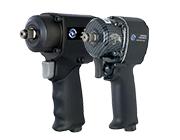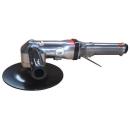bodywork polisher and air polisher

Pneumatic bodywork polisher for cars
︾
Pneumatic bodywork polisher: Presentation of the Général Pneumatique brand:
The pneumatic buffing and polishing machine is a power tool used mainly in the automotive and bodywork renovation industries to polish and buff surfaces. Unlike conventional electric models, pneumatic polishers use compressed air supplied by an air compressor. This technology offers a number of advantages, including the tool's light weight, ease of handling and reduced risk of overheating.
Here are some important features of the pneumatic polisher and buffing machine:
Adjustable power :
These tools are often equipped with an air pressure adjuster, which allows you to control the speed of rotation of the polishing head. This offers flexibility in the treatment of different surfaces and materials.
Variety of polishing heads:
Pneumatic polishers are generally compatible with a variety of polishing heads, pads and Abrasive discs. This allows users to choose the type of accessory to suit the specific task in hand.
Lightweight and manoeuvrable:
Due to their pneumatic design, these tools are generally lighter than their electric counterparts, making them easier to handle, especially when used on large surfaces.
Efficient cooling:
Unlike electric polishers, which can overheat with prolonged use, pneumatic polishers tend to stay cooler, reducing the risk of damage to the surface being worked on.
Relatively simple maintenance:
Pneumatic polishers often have fewer moving parts and electronic components than electric models, which can simplify maintenance and repair.
However, it's important to note that using a pneumatic polisher requires a quality air compressor to ensure optimum operation. In addition, appropriate training is recommended to avoid any potential damage to the surfaces treated and to ensure satisfactory polishing results.
Using the body polisher :
Using a body polisher, either a rotary or orbital polisher, can significantly improve the exterior appearance of your vehicle by removing imperfections, restoring shine and giving a smooth finish to the bodywork. Here's a general guide on how to use a body polisher:
1. Preparation:
Make sure the surface of the car is clean. Wash the car to remove dirt, dust and debris.
If necessary, decontaminate the surface with a specific product to remove contaminants such as resin, insects, etc.
If there are significant scratches, you may want to consider pre-polishing to remove them.
2. Choice of product :
Select the right polish for your bodywork. Some products are designed to remove scratches, others to restore shine.
3. Selecting the body polisher:
Use an orbital polisher for novice users or for routine work. They are generally safer and less likely to cause damage if used incorrectly.
Rotary polishers are more powerful and can remove larger defects, but require more careful handling.
4. Applying the product :
Apply a small amount of polish to the work surface or directly to the polisher pad.
Work in sections to ensure even coverage.
5. Polishing :
Start the polisher at a low speed to spread the product, then gradually increase the speed.
Work the polisher in slow, even strokes, taking care not to stay in one place for too long to avoid overheating.
Follow the product instructions and adjust the pressure and speed of the polisher accordingly.
6. Wiping :
Once polishing is complete, wipe off any excess product with a clean, soft cloth.
7. Finishing:
If necessary, apply a finishing wax to protect the bodywork and give an extra shine.
It is essential to follow the instructions of the manufacturer of the polisher and the polishing product you use. Also, practice on a small area first to familiarise yourself with the tool and avoid any unintentional damage to the bodywork.
FAQ : How to use a car polisher properly:
When it comes to polishing a car body, pneumatic polishers and buffers are tools that are highly prized for their efficiency and precision. However, many questions arise when it comes to mastering this subtle art. Here are some of the questions most frequently asked by users anxious to achieve an impeccable finish.
What's the difference between a rotary and a pneumatic orbital polisher?
Pneumatic rotary polishers make circular movements and are better suited to removing larger defects, but they require delicate handling. On the other hand, pneumatic orbital polishers make more complex movements that reduce the risk of circular marks, making them ideal for less experienced users or for routine work.
How can I avoid overheating the bodywork during pneumatic polishing?
Overheating can be a problem, especially with rotary polishers. We recommend working in sections, keeping the machine in constant motion and adjusting the speed of rotation as required. Excessive pressure can also generate heat, so apply moderate pressure and let the tool do the work.
Do I need to use a certain air pressure with my air polisher?
Each air polisher has its own air pressure specifications. Consult your tool's user manual to determine the recommended pressure. A quality air compressor is essential to ensure optimum operation of the polisher.
What type of polishing pad or disc should I use?
The choice of pads depends on the type of work. To remove larger defects, use abrasive pads. For finishing, opt for softer foam pads. Make sure you change the pads regularly to maintain optimum performance.
Do I need to use a specific polishing product with a pneumatic polisher?
Yes, the choice of polish is crucial. Some products are designed to remove scratches, while others are designed to restore shine. Choose a product suited to your specific needs and follow the manufacturer's recommendations.
By understanding these fundamental aspects of using a pneumatic body polisher, users can hone their skills and achieve polishing results worthy of professionals. The key is patience, practice and a constant search for excellence.
.jpg)
